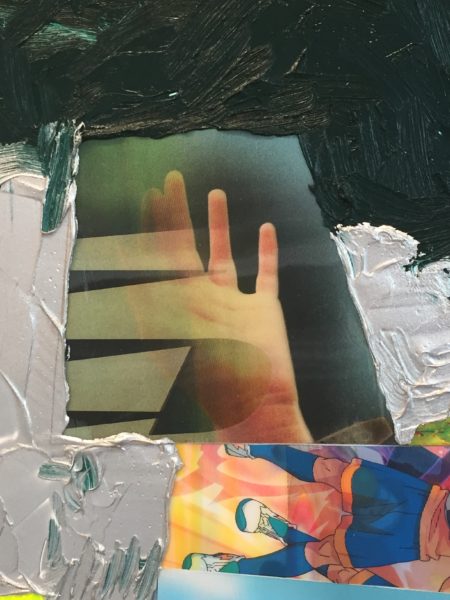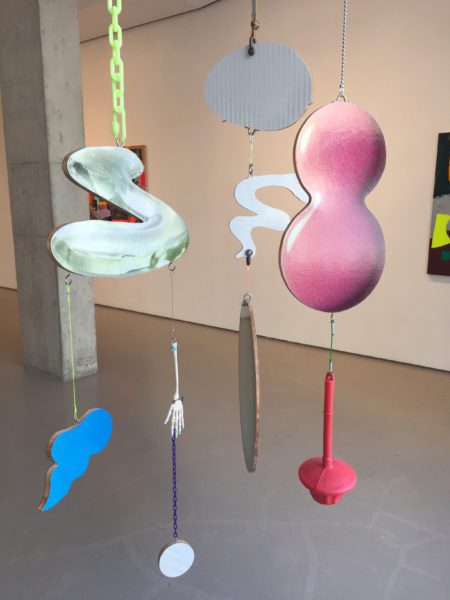Daylight emanates from the floor-to-ceiling window of Chelsea’s Jane Lombard Gallery and complements the airy ambiance of the interdisciplinary installation, Plastic Barricade. This ample exhibition space houses a myriad of two and three-dimensional works by Japanese artist, Teppei Kaneuji. Additionally, an abundance of white space creates an atmospheric effect which surrounds the brightly colored objects and paintings and avails a backdrop advantageous to the artist’s formal and conceptual intent. Plastic Barricade is Kaneuji’s second solo show at Chelsea’s Jane Lombard Gallery.

Patterned and solid silhouettes in fluorescent yellow, orange, red, and cyan consistently appear in both the paintings and sculpture and are playfully reminiscent of playschool toys or grade school science fairs. Kaneuji’s multidisciplinary installation evokes the form and color of the dually graphic and poetic languages of Modernists Alexander Calder and Joan Miro emphasized through repetitious objects connoting drips and drops, staged in dribs and drabs.

A derisive vernacular is also intrinsic in Kaneuji’s aesthetic, evinced in his lenticular painting series, ZONES, and conflates Japanese and American imagery from the iconic to everyday life, involving patriotism, fandom, anime, and manga. Equally redolent of the social critique of consumerism in the tendencies of Pop Art and Commodity Art, Keneuji ambitiously takes on the “Superflat,” or what is termed in Japanese subculture and post-Murakami, neo-pop spheres as the “Hybrid Superflat,” through triumphant painterly executions that oscillate between states of dimension and flatness. This amalgam of pictorial treatments combines photographs, paint, and pictograms to create disjointed narratives, particularly notable in such works as ZONES (Airport) #1. Here, Kaneuji superbly subverts the Superflat through lenticular imagery that shifts into multiple perspectives when traversing across it; light, form, and dimension engage in a dynamic interaction that is fully realized by one’s bodily engagement. Aimed at extending relationships to the adjacent three-dimensional installations, these wood panels are encased in textural globs resembling mold-making processes; one can still detect the scent of thickly impastoed oils covering the freshly painted surfaces.

On a separate wall, other paintings from the ZONES series diverge from the rectangle with outer contours intimating objects in the Mobiles and tabletop installation, HAKUCHIZU (white map). Representational pop culture and advertising icons deftly merge at the seams into flat abstract shapes, securing complex friction between picture plane and picture frame through the addition of reflective stickers.

Rethinking powder and the apocalyptic, the tabletop display, HAKUCHIZU, toys with Japanese and American notions of the temporal and the preternatural. From a bird’s-eye view, this diorama, a quasi-tabula rasa, provides a subtle overview of what appears to be 3D printed and readymade objects of life and death. The mysterious powder exudes a quieting effect by blanketing the colorful plastic and metallic forms in white, making for a “clean slate.” Recalling such nostalgic items as holiday displays or the art of confectionery, these dusted forms symbolize tools and toys for both work and play. Linking cogently to the white debris and 3D printing are delicate confectionery doilies often used in conjunction with baking molds.

Of the two sculptures from the artist’s Mobiles series, Ghost in the Liquid Room (Make-up Shadow/Mobile) #L, window-displayed in the gallery, carries the most visual impact. Like its cohort Ghost in the Liquid Room (Make-up Shadow/Mobile) #S, it includes an assortment of consumer objects “chained” in plastic, metal and wood that then dangle in a semi-cascading manner. Suspended from skeletal structures, a sparkling melee of media includes playful pop-art and advertising-influenced imagery, such as thought bubbles, plungers, and human bone fragments that serve as three-dimensional simulations of the paintings. This framework borrows once more from Calder and Miro, yet Kaneuji’s mobiles employ less systematic, more quirky balancing techniques that cause them to look more fragmented and incomplete.

Plastic Barricade clearly seeks to pay forward the visual conversations of its precursors – Modernism, Commodity Art, and the Superflat. Dichotomous relationships which seek commentary on consumer culture are prevalent in the work as well as an irrefutable ambivalence. In its formal elegance and critical distancing, however, it remains dually complicit. And despite formidable implications of the militaristic, indications of a collective consciousness and an expressed human frailty run throughout the exhibition. With that said, Plastic Barricade proves to be a powerful interdisciplinary presentation in which Teppei Kaneuji puts up no walls or defenses.
Plastic Barricade is on view May 23 – July 3. Teppei Kaneuji was born in Japan in 1978 and received a Graduate Degree in sculpture from Kyoto City University of the Arts in 2003. He has exhibited nationally and abroad, including solo exhibitions at Towering Something, Ullens Center for Contemporary Art, Beijing, and K11, Shanghai (2013-14), and ZONES, Marugame Geniciro-Inokuma Museum of Contemporary Art in Kagawa, Japan (2016). Kaneuji currently resides in Kyoto, Japan.
Photos courtesy of the artist Jane Lombard Gallery. Photos by Arturo Sanchez.
